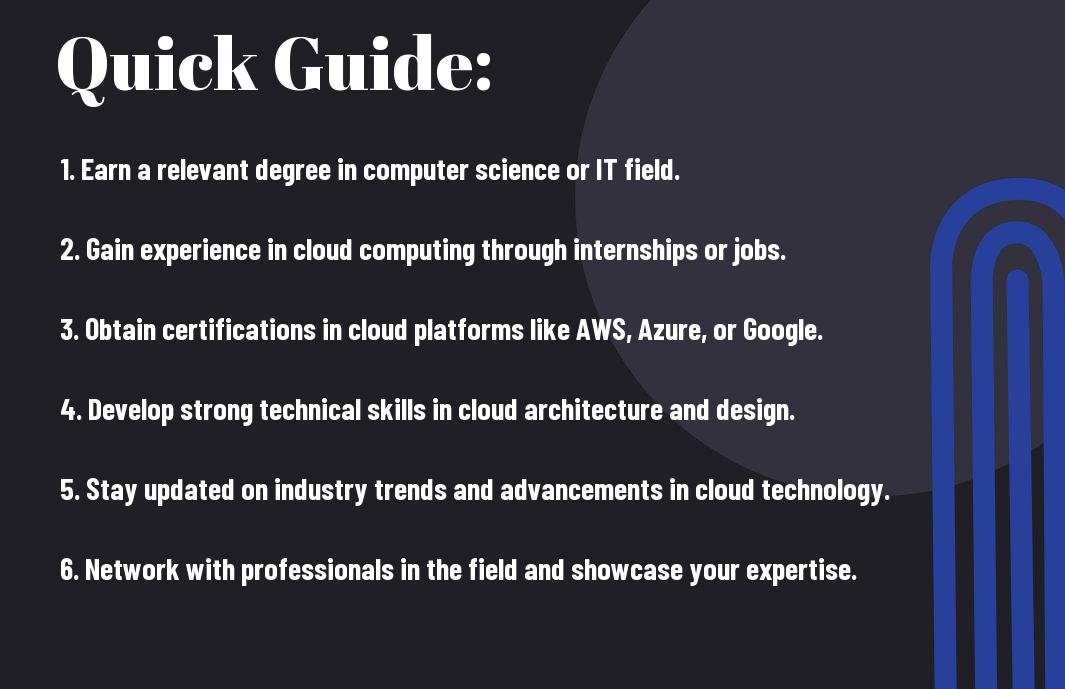You have decided to commence on a journey to become a successful cloud architect. Congratulations on taking this significant step towards a lucrative and fulfilling career in the ever-evolving world of technology. As businesses continue to migrate their operations to the cloud, the demand for skilled cloud architects is steadily rising. However, navigating the path to success in this competitive field requires a strategic approach and dedication to honing your skills.
In this comprehensive guide, we will walk you through the important steps you need to take to carve out a successful career as a cloud architect. From acquiring the necessary skills and certifications to gaining practical experience and staying ahead of industry trends, we will provide you with insights and tips that will set you on the right path. By following these steps diligently and remaining committed to continuous learning and growth, you can position yourself as a sought-after cloud architect in today’s job market.
Key Takeaways:
- Understand the Basics: Before stepping into cloud architecture, make sure you have a solid understanding of the basics of cloud computing.
- Develop Technical Skills: Focus on gaining technical skills in areas like networking, security, virtualization, and scripting languages.
- Obtain Certifications: Industry-recognized certifications like AWS Certified Solutions Architect or Google Cloud Certified Professional Cloud Architect can boost your career.
- Gain Hands-On Experience: Practical experience is key to becoming a successful cloud architect, so seek opportunities to work on real-world projects.
- Stay Updated: Cloud technology is constantly evolving, so it’s important to stay updated with the latest trends and advancements in the field.
- Develop Soft Skills: Communication, problem-solving, and leadership skills are crucial for a cloud architect to effectively collaborate with teams and clients.
- Build a Professional Network: Networking with industry experts, attending conferences, and joining online communities can help you grow your career as a cloud architect.

Understanding the Cloud Architect Role
Definition of a Cloud Architect
Some enterprises are shifting their infrastructure to cloud environments to improve efficiency, scalability, and cost-effectiveness. This trend has led to the rise in demand for Cloud Architects. Cloud Architects are professionals who oversee an organization’s cloud computing strategy and are responsible for deploying, managing, and supporting cloud applications.
Cloud Architects design and adopt cloud services based on the organization’s business requirements, ensuring that the infrastructure is secure, reliable, and scalable. They possess in-depth knowledge of cloud platforms, infrastructure, and application architecture.
Key Responsibilities and Duties
On a daily basis, Cloud Architects work closely with IT teams, developers, and stakeholders to understand the organization’s goals and technical requirements. They design cloud environments, select appropriate cloud services, and implement security measures to protect sensitive data.
The role of a Cloud Architect also includes monitoring performance, troubleshooting issues, and optimizing cloud infrastructure to ensure maximum efficiency and uptime.
Skills and Qualities of a Successful Cloud Architect
Cloud Architects need to possess a combination of technical skills and soft skills to excel in their roles. They should have a deep understanding of cloud technologies, programming languages, and networking concepts. Problem-solving skills, communication skills, and the ability to work in a team environment are also crucial for Cloud Architects.
Architect ensuring that Cloud Architects stay up-to-date with the latest trends and technologies in cloud computing is crucial for their professional growth and success in the field. Continual learning and certifications can help Cloud Architects stay competitive and advance their careers.
Types of Cloud Architectures
Many organizations today are leveraging different cloud architectures to meet their diverse business needs. Understanding the various types of cloud architectures is crucial for aspiring cloud architects in order to design effective cloud solutions for their clients. In this chapter, we will discuss the four main types of cloud architectures: Public Cloud, Private Cloud, Hybrid Cloud, and Multi-Cloud.
| Public Cloud | Shared resources, accessible over the internet |
| Private Cloud | Single tenant, dedicated resources |
| Hybrid Cloud | Combination of public and private clouds |
| Multi-Cloud | Use of multiple cloud providers |
| This table summarizes the key characteristics of each type of cloud architecture. | |
Public Cloud Architectures
With Public Cloud Architectures, organizations benefit from cost-effective solutions as they pay only for the services they use. The scalability and flexibility of public clouds make them ideal for startups and small businesses looking to expand their IT capabilities without significant upfront investments. Additionally, public cloud providers handle maintenance, security, and updates, allowing organizations to focus on their core business activities.
Despite the advantages, public cloud architectures may raise concerns around data security and compliance, especially for organizations dealing with sensitive information. It is crucial for cloud architects to design robust security measures and carefully assess regulatory requirements when opting for a public cloud solution.
Private Cloud Architectures
The Private Cloud Architecture offers organizations greater control and customization over their cloud environment. By hosting resources on-premises or in a dedicated cloud infrastructure, businesses can address specific requirements related to security, compliance, and performance. The private cloud is often preferred by enterprises handling confidential data or operating in highly regulated industries.
Plus, private cloud architectures provide predictable performance and reliability, as resources are not shared with other organizations. This dedicated approach ensures that businesses can meet their unique IT demands without compromising on data privacy or compliance.
Hybrid Cloud Architectures
Architectures incorporate aspects of both public and private clouds, allowing organizations to leverage the benefits of both environments. By using a combination of on-premises infrastructure, private cloud services, and public cloud resources, businesses can achieve flexibility, scalability, and cost-efficiency. Hybrid cloud architectures are ideal for organizations with fluctuating workloads or diverse IT requirements.
Cloud in hybrid cloud architectures must carefully manage data integration, security, and workload distribution across the different environments to ensure seamless operations. This requires a strategic approach to designing the architecture and implementing robust management and monitoring mechanisms.
Multi-Cloud Architectures
Cloud involve using multiple cloud providers to distribute workloads and mitigate the risks of vendor lock-in and potential service disruptions. By spreading applications and data across different cloud platforms, organizations can enhance resilience, performance, and compliance by leveraging the unique strengths of each provider.
For instance, organizations can use one cloud provider for data storage and another for computing tasks to optimize costs and performance. However, managing multiple cloud environments requires advanced skills and tools to ensure seamless integration and efficient operations.

Educational Pathways
Despite the wide array of paths that can lead to a successful career as a cloud architect, there are some common educational routes that aspiring professionals may consider. From academic qualifications to online courses and certifications, there are various options to choose from when aiming to become a proficient cloud architect.
Academic Qualifications
Qualifications: Obtaining a bachelor’s degree in computer science, information technology, or a related field can provide a solid foundation for a career in cloud architecture. Advanced degrees, such as a master’s or PhD, can also be beneficial for those looking to specialize further in cloud computing.
Academic institutions often offer specialized programs or concentrations in cloud computing, which can provide students with in-depth knowledge and practical skills in the field. These programs may cover topics such as cloud infrastructure, security, and deployment strategies, preparing students for the demands of a cloud architect role.
Online Courses and Certifications
Online: In addition to traditional academic pathways, online courses and certifications can be valuable resources for individuals looking to enhance their skills in cloud architecture. Platforms like Coursera, Udemy, and LinkedIn Learning offer a variety of courses on cloud computing, architecture, and related technologies.
Certifications: Professional certifications such as AWS Certified Solutions Architect, Google Professional Cloud Architect, and Microsoft Certified: Azure Solutions Architect can demonstrate expertise in specific cloud platforms and technologies. These certifications can help professionals stand out in a competitive job market and validate their skills to potential employers.
Bootcamps and Workshops
Qualifications: Bootcamps and workshops are intensive, short-term training programs that focus on practical skills and real-world applications. These programs can be a great option for individuals looking to quickly upskill and gain hands-on experience in cloud architecture.
For instance, programs like Google Cloud Platform Bootcamp or AWS Architect Workshop can provide participants with the opportunity to work on real cloud projects, collaborate with industry professionals, and build a portfolio of work that showcases their abilities to prospective employers.
Gaining Practical Experience
Not only is theoretical knowledge important in becoming a successful cloud architect, but gaining practical experience is also crucial. Employers look for candidates who have hands-on experience working with cloud technologies in real-world scenarios.
Internships and Apprenticeships
To gain practical experience, consider pursuing internships or apprenticeships with companies that specialize in cloud computing. These opportunities allow you to work alongside experienced professionals, gaining valuable insights into the day-to-day operations of cloud architecture.
Internships and apprenticeships provide hands-on experience that can be invaluable in building your skills and confidence as a cloud architect. By actively participating in projects and tasks, you can apply your theoretical knowledge to real-world scenarios and learn best practices from industry experts.
Contributing to Open-Source Projects
With the widespread use of open-source technologies in cloud computing, contributing to open-source projects can also help you gain practical experience. By collaborating with developers from around the world on projects like Kubernetes or OpenStack, you can expand your knowledge and enhance your skills in cloud architecture.
Internships
Finding internship opportunities or projects in the cloud computing field can provide you with hands-on experience and the chance to work on real-world problems. As an intern, you can gain insight into the industry while building your network and credibility in the field.
Freelancing and Small-Scale Projects
Any experience working on freelance projects or small-scale cloud initiatives can also contribute to your practical knowledge as a cloud architect. Taking on independent projects allows you to apply your skills in a real-world setting and gain exposure to different aspects of cloud architecture.
Experience
While freelancing may involve more risk and uncertainty, it can offer valuable experience and the opportunity to work on a variety of projects that can help build your portfolio and reputation in the industry.
Obtaining Relevant Certifications
Your journey to becoming a successful cloud architect starts with obtaining relevant certifications. These certifications not only validate your skills and expertise but also showcase your dedication to the field. Here are some of the most sought-after certifications that can help you excel in your career as a cloud architect:
AWS Certified Solutions Architect
One of the most recognized certifications in the cloud computing industry is the AWS Certified Solutions Architect certification. This certification demonstrates your ability to design and deploy scalable, highly available, and cost-effective systems on the Amazon Web Services platform. By obtaining this certification, you will gain a deep understanding of AWS services, best practices, and architectural design principles.
Architect Your industry credibility and demand as a cloud architect will significantly increase with an AWS Certified Solutions Architect certification under your belt.
Microsoft Certified: Azure Solutions Architect Expert
Another valuable certification for aspiring cloud architects is the Microsoft Certified: Azure Solutions Architect Expert certification. This certification showcases your expertise in designing and implementing solutions that run on Microsoft Azure.
Plus, With this certification, you demonstrate your ability to translate business requirements into scalable, secure, and reliable cloud solutions using Azure services.
Google Cloud Certified – Professional Cloud Architect
Microsoft Another key certification that can elevate your career as a cloud architect is the Google Cloud Certified – Professional Cloud Architect certification. This certification demonstrates your ability to design and plan a cloud solution architecture on the Google Cloud platform.
Azure By acquiring this certification, you prove your proficiency in Google Cloud technologies and your capability to leverage Google Cloud services to build cutting-edge solutions.
Tips for Preparing for Certification Exams
When preparing for certification exams, it’s vital to have a solid study plan and strategy in place. Here are some tips to help you effectively prepare for your cloud architect certification exams:
- Understand the Exam Objectives: Familiarize yourself with the exam objectives and focus your studies on the key areas outlined.
- Practice, Practice, Practice: Hands-on experience is crucial for success in certification exams. Spend time working on practical exercises and real-world scenarios.
Knowing what to expect and how to best prepare for your certification exams will increase your chances of success and help you achieve your goals in becoming a certified cloud architect.
Essential Technical Skills
Proficiency in Cloud Service Providers’ Platforms
The ability to navigate and utilize various cloud service providers’ platforms effectively is necessary for a successful cloud architect. The understanding of the intricate details and features of platforms such as Amazon Web Services (AWS), Microsoft Azure, and Google Cloud Platform is crucial for implementing and managing cloud solutions.
Proficiency in services like virtual machines, databases, storage solutions, and networking within these platforms is paramount. The ability to select the right services to meet specific project requirements and optimize costs is a valuable skillset for any cloud architect.
Mastery of DevOps Practices
Skills in DevOps practices, including continuous integration, continuous delivery, automation, and collaboration between development and operations teams, are highly sought after in the industry. The ability to streamline processes, improve efficiency, and increase the speed of software delivery sets successful cloud architects apart.
Plus, a deep understanding of tools like Jenkins, Docker, Kubernetes, and Git is crucial for implementing DevOps practices effectively in cloud environments. Skills in scripting languages such as Python, Bash, or PowerShell are also valuable for automation and infrastructure management.
Understanding of Infrastructure as Code (IaC)
Infrastructure as Code (IaC) is a critical concept for cloud architects as it allows for the automated provisioning and management of infrastructure through code. Infrastructure as Code tools like Terraform and CloudFormation enable architects to define infrastructure in a declarative manner, increasing scalability, consistency, and efficiency.
Essential for cloud architects is the ability to write infrastructure code, version control it, and perform automated testing to ensure reliability and repeatability in cloud environments.
Security and Compliance Knowledge
Security and compliance knowledge is non-negotiable for cloud architects given the sensitivity of data and the potential risks associated with cloud environments. A thorough understanding of security best practices, compliance requirements, and data protection regulations is imperative to design and implement secure cloud solutions.
A focus on confidentiality, integrity, and availability of data, along with expertise in encryption, identity and access management, and security monitoring, are necessary for safeguarding cloud environments against cyber threats and ensuring regulatory compliance.
Soft Skills and Business Acumen
Unlike technical skills, soft skills play a crucial role in the success of a cloud architect. Communication and Leadership are two key soft skills that are highly valued in this role.
Communication and Leadership
An effective cloud architect must possess strong communication skills to convey complex technical information in a clear and concise manner. Leadership skills are also vital as they often lead multidisciplinary teams in designing and implementing cloud solutions.
Project Management
Acumen in project management is necessary for a successful cloud architect. They must be able to plan, execute, and oversee projects to ensure successful implementation of cloud solutions.
Soft skills are often underestimated in the technical field, but they are just as important as technical skills in the role of a cloud architect. Financial Analysis for Cloud Solutions is another critical aspect that requires a blend of technical expertise and business acumen.
Financial Analysis for Cloud Solutions
To effectively design and implement cost-effective cloud solutions, a cloud architect must possess financial analysis skills. This involves evaluating costs, benefits, and risks associated with different cloud solutions to make informed decisions.
Stakeholder Management and Negotiation are crucial skills for a cloud architect to possess. They must be able to effectively engage with stakeholders and negotiate terms to ensure successful implementation of cloud solutions.
Stakeholder Management and Negotiation
One of the key responsibilities of a cloud architect is to manage relationships with stakeholders and negotiate agreements that meet the needs of all parties involved. With effective stakeholder management and negotiation skills, a cloud architect can ensure the successful adoption of cloud solutions within an organization.
Building a Professional Network
Once again, building a strong professional network is crucial for success as a Cloud Architect. Networking can open up opportunities for collaboration, knowledge sharing, and career advancement. In this chapter, we will explore various strategies to help you build and leverage a professional network in the tech industry.
Leveraging Social Media Platforms
Professional networking on social media platforms like LinkedIn, Twitter, and specialized online forums can be a powerful tool for connecting with industry professionals, sharing your expertise, and staying updated on the latest trends in cloud computing. Make sure your profiles are up-to-date and engaging, and regularly participate in relevant discussions to establish yourself as a thought leader in the field.
Attending Conferences and Workshops
With the rapid evolution of cloud technologies, attending conferences and workshops is important for staying current with industry trends, connecting with peers, and expanding your knowledge base. These events provide valuable opportunities to learn from experts, participate in hands-on workshops, and network with potential collaborators or employers.
Social media platforms can be used to stay informed about upcoming conferences and workshops in your area or related to your areas of interest. Many events also offer virtual attendance options, making it easier to participate from anywhere in the world.
Joining Professional Associations
Conferences and workshops are great places to meet like-minded professionals and discover industry-specific associations that align with your career goals. Joining professional associations such as the Cloud Security Alliance or the International Association of Cloud & Managed Service Providers can provide access to valuable resources, networking opportunities, and industry insights.
Media association memberships often include benefits such as access to exclusive events, training programs, and job boards. Engaging with these associations can help you stay connected with the latest trends and developments in cloud architecture, as well as expand your professional network.
Creating an Effective Resume and Portfolio
All successful cloud architects have one thing in common – a standout resume and portfolio. These two components are necessary for landing your dream job in the competitive field of cloud architecture. Here’s how to make sure yours shines.
How to Showcase Your Skills and Experience
Experience is key when it comes to proving your worth as a cloud architect. Make sure your resume highlights all relevant work experience, projects, certifications, and skills related to cloud computing. Be sure to quantify your achievements where possible, such as the number of successful cloud migrations you’ve led or the amount of cost savings you’ve achieved for previous employers.
When creating your portfolio, include detailed case studies that showcase your problem-solving abilities and project management skills. Potential employers want to see real-world examples of your work, so be sure to include a variety of projects that demonstrate your expertise in different areas of cloud architecture.
Writing a Compelling Cover Letter
Portfolio is just as important as your resume when it comes to making a strong impression on potential employers. Your cover letter is your chance to introduce yourself and explain why you’re the perfect candidate for the job. Use this opportunity to showcase your passion for cloud architecture and highlight specific achievements that make you stand out from the crowd.
Preparing for Interviews: Tips and Best Practices
To ace the interview process, it’s necessary to be well-prepared. Skills you should focus on highlighting during interviews include your technical expertise in cloud platforms like AWS, Azure, or Google Cloud, your problem-solving abilities, and your communication skills. Be prepared to discuss specific projects you’ve worked on and how you’ve contributed to their success.
- Research the company and the role beforehand
- Be ready to discuss your past experiences and how they relate to the job
- Ask insightful questions about the company and the team
- Follow up with a thank you email after the interview. Knowing proper interview etiquette can make a big difference in how you’re perceived by potential employers.
Advancing in Your Career
The Role of Continuous Learning
One imperative factor in advancing your career as a successful cloud architect is the commitment to continuous learning. The cloud computing industry is ever-evolving with new technologies, trends, and best practices emerging regularly. To stay relevant and competitive in this dynamic field, cloud architects must dedicate themselves to lifelong learning.
Continuous learning can take various forms, such as enrolling in certification courses, attending industry conferences and workshops, reading publications, and participating in online forums. By staying abreast of the latest developments and deepening your expertise, you can position yourself as an invaluable asset within your organization and the industry as a whole.
Considering Specialization
Career advancement in cloud architecture often involves considering specialization. As the field grows and diversifies, there are opportunities to carve out a niche for yourself based on your interests, strengths, and the needs of the market. Specializing in a specific area such as security, data management, or automation can set you apart from your peers and open up new avenues for career growth.
The decision to specialize should be strategic, informed by your goals and the trends in the industry. By focusing your efforts on a particular specialization, you can become a subject matter expert and command higher positions and salaries within the cloud architecture domain.
Leadership Roles in Cloud Architecture
The leadership roles in cloud architecture offer a unique opportunity for professionals to showcase their expertise and influence the direction of projects and teams. Cloud architects who demonstrate strong technical skills, strategic thinking, and effective communication often find themselves in leadership positions, such as cloud solution architect, cloud project manager, or cloud team lead.
With leadership roles come greater responsibilities and challenges, but also the chance to shape the future of cloud technology within an organization. These roles require a blend of technical acumen and soft skills like leadership, teamwork, and mentorship to guide teams towards successful project outcomes and organizational goals.
To succeed in a leadership role in cloud architecture, professionals must cultivate a combination of technical expertise, business acumen, and interpersonal skills. By demonstrating leadership qualities and taking on increasing levels of responsibility, cloud architects can position themselves for career advancement and make a significant impact on the organizations they serve.
The Pros and Cons of Being a Cloud Architect
For a professional considering a career as a Cloud Architect, it’s necessary to weigh the advantages and challenges associated with the role. Below is a breakdown of the pros and cons that come with being a Cloud Architect:
| Pros | Cons |
| High demand in the job market | Constant need to stay updated with ever-evolving technologies |
| Lucrative salary potential | Pressure to deliver scalable and secure solutions |
| Opportunity to work on diverse projects | Long working hours to meet project deadlines |
| Possibility for career growth and advancement | High levels of stress due to the critical nature of projects |
| Chance to collaborate with cross-functional teams | Responsibility for the success of large-scale deployments |
Advantages of the Profession
Prospective Cloud Architects are attracted to the profession for several compelling reasons. Firstly, the high demand in the job market ensures that skilled professionals have numerous employment opportunities available to them. Additionally, the lucrative salary potential in this field is a significant motivator for many individuals looking to excel in their careers.
Furthermore, the opportunity to work on diverse projects provides Cloud Architects with a dynamic and engaging work environment. This variety not only keeps the job interesting but also allows architects to continuously enhance their skills and expertise across different platforms and technologies.
Challenges Faced by Cloud Architects
One of the key challenges faced by Cloud Architects is the constant need to stay updated with ever-evolving technologies. The fast-paced nature of the industry means that architects must continuously upskill and adapt to new tools and techniques to remain competitive in the field. Additionally, the pressure to deliver scalable and secure solutions can be overwhelming, requiring architects to stay sharp and focused at all times.
Architects also face long working hours to meet project deadlines, often leading to high levels of stress. The responsibility for the success of large-scale deployments can weigh heavily on architects, requiring them to demonstrate resilience and problem-solving skills in challenging situations.
Work-Life Balance Considerations
For Cloud Architects, maintaining a healthy work-life balance can be a significant challenge. The demanding nature of the profession often requires architects to work long hours, including weekends and holidays, to meet project deadlines and ensure the success of deployments. This can impact personal relationships and overall well-being if not managed effectively.
Plus, it’s crucial for Cloud Architects to prioritize self-care and establish clear boundaries between work and personal life to avoid burnout and maintain long-term career sustainability. Finding ways to decompress and recharge outside of work hours is necessary for architects to perform at their best and navigate the challenges of the profession successfully.
Factors Influencing Success as a Cloud Architect
After begining on the journey to become a successful Cloud Architect, it is crucial to understand the various factors that can influence your success in this role. By recognizing and adapting to these key elements, you can position yourself for a rewarding career in cloud architecture.
Industry Trends and Innovation
Trends in the tech industry are constantly evolving, with new advancements and innovations shaping the way we work with cloud technologies. As a Cloud Architect, staying abreast of these trends is imperative to anticipate future needs and challenges in the field. Embracing innovation and understanding how it impacts cloud infrastructure can set you apart in a competitive industry.
Technologies within the cloud space are continuously evolving, from serverless computing to containerization. To succeed as a Cloud Architect, you must have a willingness to learn and adapt to these new technologies swiftly. Developing expertise in emerging tools and platforms will not only enhance your skill set but also keep you relevant in the fast-paced world of cloud computing.
Importance of Mentorship and Peer Feedback
Influencing your success as a Cloud Architect is the guidance and support you receive from mentors and peers. Establishing relationships with experienced professionals in the field can provide valuable insights and advice as you navigate your career path. Peer feedback is equally valuable, offering different perspectives and constructive criticism to help you grow professionally.
The knowledge and wisdom gained through mentorship can accelerate your career progression and help you avoid common pitfalls in the industry. Building a network of mentors and peers who can offer guidance and support will not only enhance your skills but also boost your confidence as you tackle complex cloud architecture projects.
Assume that staying updated on industry trends, embracing new technologies, and seeking mentorship are crucial components in achieving success as a Cloud Architect.
A Step-by-Step Roadmap to Success
All information is broken down into the following table:
| Year 1: Building a Foundation | Year 2: Gaining Experience and Networking |
Year 1: Building a Foundation
The first year of your journey to becoming a successful cloud architect is crucial. Building a solid foundation in cloud computing fundamentals is necessary. This includes mastering key concepts such as virtualization, networking, security, and storage. It is also important to gain hands-on experience with cloud platforms like Amazon Web Services (AWS), Microsoft Azure, and Google Cloud Platform.
Additionally, pursuing relevant certifications such as AWS Certified Solutions Architect, Microsoft Certified: Azure Solutions Architect Expert, or Google Professional Cloud Architect can help validate your skills and knowledge in the field.
Year 2: Gaining Experience and Networking
Foundation: In the second year, focus on gaining practical experience by working on real-world cloud projects either at your current job or through freelance opportunities. Networking with other professionals in the industry can also open doors to new opportunities and collaborations.
For instance, attending industry conferences, joining online forums and communities, and participating in hackathons can help you connect with like-minded individuals and learn from their experiences.
Year 3: Specialization and Leadership
Foundation: By the third year, consider specializing in a specific area of cloud architecture such as cloud security, DevOps, or big data analytics. Developing leadership skills is also crucial at this stage, as it can set you apart in the competitive field of cloud computing.
With more experience under your belt, you may have the opportunity to lead projects, mentor junior team members, or even speak at industry events to share your expertise and insights.
Year 4 and Beyond: Ongoing Growth and Contributions
Year: As you progress into the fourth year and beyond, focus on continuing to grow your skills and knowledge in cloud architecture. Stay updated on the latest industry trends, technologies, and best practices by pursuing advanced certifications, attending workshops, and engaging in continuous learning.
Networking: Additionally, consider giving back to the community by sharing your knowledge through blogs, white papers, or mentoring opportunities. Making meaningful contributions to the field can not only solidify your expertise but also establish you as a thought leader in cloud architecture.
Conclusion
Ultimately, becoming a successful cloud architect requires a strong foundation in cloud computing fundamentals, mastering relevant technologies, acquiring certifications, gaining practical experience through internships or projects, and continuously upgrading your skills. Cloud architects play a key role in designing, implementing, and managing cloud infrastructure for organizations, making it a rewarding and in-demand career path. This step-by-step guide has provided you with a roadmap to start your journey towards becoming a proficient cloud architect.
If you are interested in learning more about how to become a Cloud Architect, you can refer to this comprehensive guide on How to become a Cloud Architect [Full Guide]. Take the first step today, invest in your education, develop your skills, and embrace the opportunities that cloud computing offers for your career growth.
FAQ
Q: What is a Cloud Architect?
A: A Cloud Architect is responsible for overseeing a company’s cloud computing strategy. They design, plan, and implement cloud-based systems to ensure they are secure, reliable, and scalable.
Q: What skills are required to become a Cloud Architect?
A: To become a successful Cloud Architect, you need a strong understanding of cloud technology, experience with cloud platforms, knowledge of security and compliance, excellent communication skills, and the ability to architect and design cloud-based solutions.
Q: What is the step-by-step guide to becoming a Cloud Architect?
A: The steps to becoming a successful Cloud Architect include obtaining relevant education and certifications, gaining experience in cloud technology, developing strong technical skills, building a professional network, and staying updated on the latest industry trends.
Q: What are the imperative certifications for a Cloud Architect?
A: Some of the key certifications for Cloud Architects include AWS Certified Solutions Architect, Microsoft Certified: Azure Solutions Architect, Google Professional Cloud Architect, and Certified Cloud Security Professional (CCSP).
Q: How important is hands-on experience for a Cloud Architect?
A: Hands-on experience is crucial for a Cloud Architect as it allows them to apply their knowledge in real-world scenarios, troubleshoot issues, and understand the practical implications of their design decisions.
Q: What are the common challenges faced by Cloud Architects?
A: Some common challenges faced by Cloud Architects include security concerns, integration issues with existing systems, scalability issues, compliance requirements, and keeping up with rapidly evolving technology.
Q: How can one stay updated with the latest trends in cloud technology?
A: To stay updated with the latest trends in cloud technology, Cloud Architects can attend industry conferences, participate in webinars and online courses, join professional organizations, follow thought leaders in the field, and experiment with new technologies in a lab environment.







